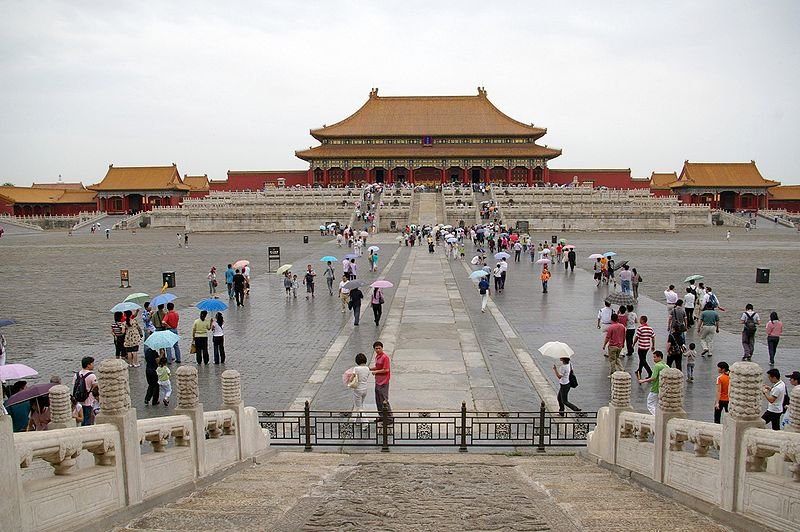 Hall of Supreme Harmony, Forbidden City
Hall of Supreme Harmony, Forbidden CitySource: http://commons.wikimedia.org/wiki/File:20090528_Beijing_Forbidden_City_7745.jpg
Author: Jakub Halun

The Forbidden City in Beijing was the Chinese Imperial Palace from the mid-Ming Dynasty to the end of the Qing Dynasty. Inscribed as a World Heritage Sites by Unesco, it is also listed as the largest collection of preserved ancient wooden structures in the world. Covering an area of 720,000 square metres, the Forbidden City comprises 800 buildings with a total of 8886 rooms.Today it houses the Palace Museum.
The Forbidden City was inscribed as a World Heritage Site during the 11th session of the World Heritage Committee which met in Headquarters in Paris, France, on 7-11 December, 1987.
The inscription was entitled Imperial Palaces of the Ming and Qing Dynasties in Beijing and Shenyang, and includes also the Imperial Palace of the Qing Dynasty in Shenyang, comprising 114 buildings built from 1625 to 1783. In the inscription, the Forbidden City was lauded for being the largest collection of preserved ancient wooden structures in the world.
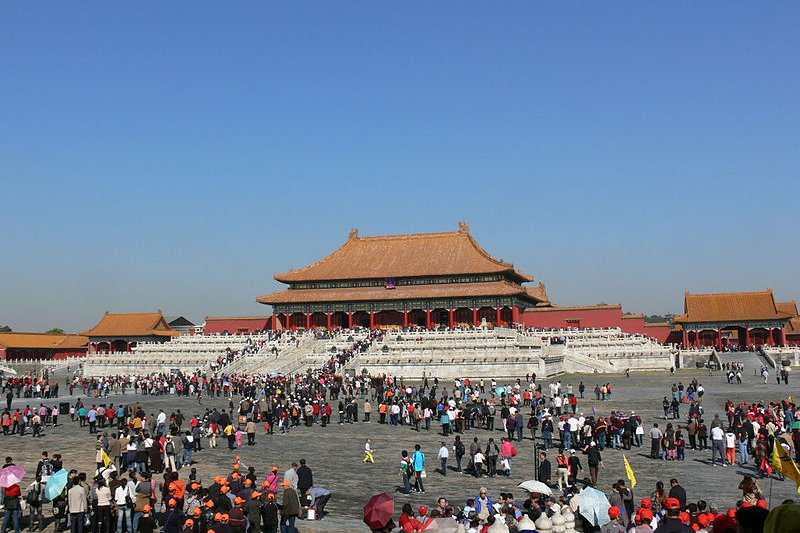 Forbidden City, Beijing
Forbidden City, Beijing
Author: Jakub Halun

The Forbidden City in Beijing was the Chinese Imperial Palace from the mid-Ming Dynasty to the end of the Qing Dynasty. Inscribed as a World Heritage Sites by Unesco, it is also listed as the largest collection of preserved ancient wooden structures in the world. Covering an area of 720,000 square metres, the Forbidden City comprises 800 buildings with a total of 8886 rooms.Today it houses the Palace Museum.
The Forbidden City was inscribed as a World Heritage Site during the 11th session of the World Heritage Committee which met in Headquarters in Paris, France, on 7-11 December, 1987.
The inscription was entitled Imperial Palaces of the Ming and Qing Dynasties in Beijing and Shenyang, and includes also the Imperial Palace of the Qing Dynasty in Shenyang, comprising 114 buildings built from 1625 to 1783. In the inscription, the Forbidden City was lauded for being the largest collection of preserved ancient wooden structures in the world.
 Forbidden City, Beijing
Forbidden City, BeijingSource: http://commons.wikimedia.org/wiki/File:Forbidden_City_Courtyard.jpg
Author: Rabs003

A 6m-deep, 52-metre wide moat encircle it, along with an 8-metre high wall. The walls are 8.62 metres at the base, and 6.66 metres at the top, and designed to withstand attacks by cannon. At the four corners where the walls meet are towers with intricate roofs. These are reproduction of the Pavilion of Prince Teng and the Yellow Crane Pavilion from Song Dynasty paintings.
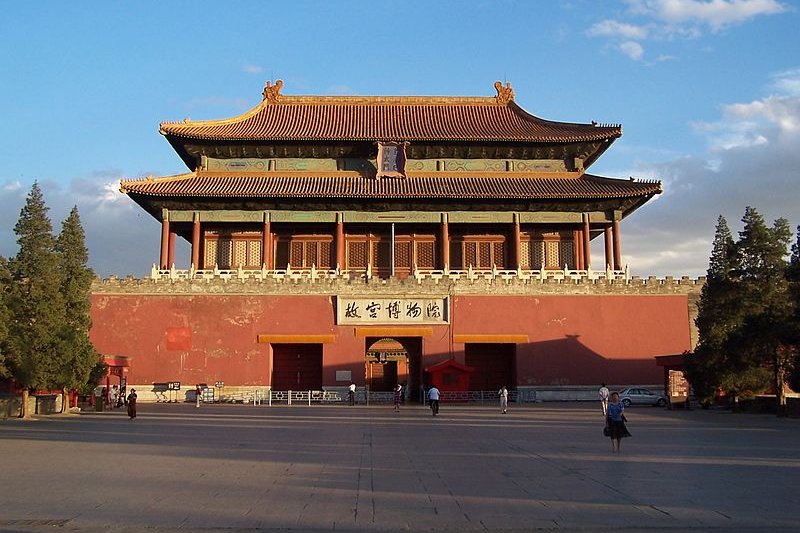 Shenwumen Gate (Gate of Divine Might), Forbidden City
Shenwumen Gate (Gate of Divine Might), Forbidden City
Author: Rabs003

Layout of the Forbidden City
The Forbidden City covers a 720,000 sq metre rectangular area measuring 961m from north to south, and 753m from east to west. Surrounding the Forbidden City is a larger, walled area called the Imperial City, and surrounding the Imperial City is the Inner City and to its south, the Outer City.A 6m-deep, 52-metre wide moat encircle it, along with an 8-metre high wall. The walls are 8.62 metres at the base, and 6.66 metres at the top, and designed to withstand attacks by cannon. At the four corners where the walls meet are towers with intricate roofs. These are reproduction of the Pavilion of Prince Teng and the Yellow Crane Pavilion from Song Dynasty paintings.
 Shenwumen Gate (Gate of Divine Might), Forbidden City
Shenwumen Gate (Gate of Divine Might), Forbidden CitySource: http://commons.wikimedia.org/wiki/File:Forbidden_City_Beijing_Shenwumen_Gate.JPG
Author: kallgan

Inscription Year: 1987 with extension in 2004
Type of Site: Cultural
Inscription Criteria: I, II, III, IV Forbidden City is located at the heart of Beijing. Indeed all places in Beijing radiates out from it. Other tourist attractions such as the Tiananmen Square, Great Hall of the People, and the newly built National Centre of the Performing Arts are located within the vicinity. The Temple of Heaven is located further south while the Beijing Olympic Complex is located directly to the north.
There are four gates into the Forbidden City. The main one, on the southern end, is called the Meridian Gate. On the north is the Gate of Divine Might, facing Jingshan Park. On the east and west are the East Glorious Gate and West Glorious gate.
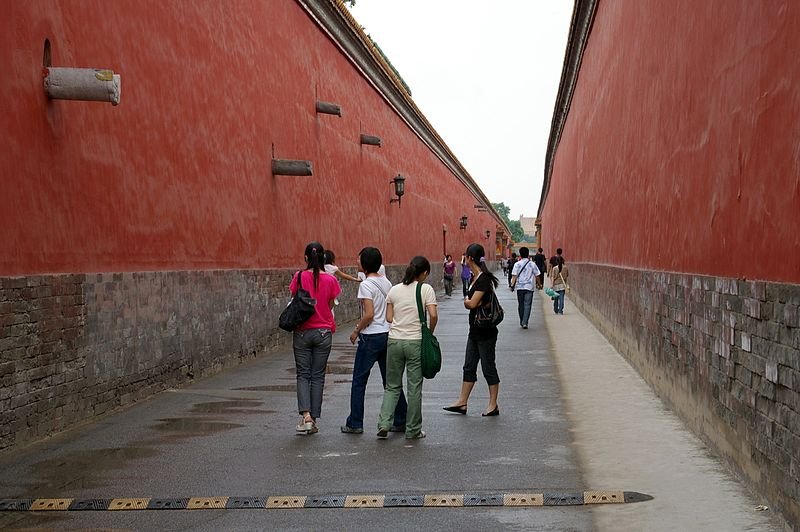 Imperial Walls of the Forbidden City
Imperial Walls of the Forbidden City
Author: kallgan

World Heritage Site Inscription Details
Location: N 39 54 58.8 E 116 23 27.2 in Beijing and ShenyangInscription Year: 1987 with extension in 2004
Type of Site: Cultural
Inscription Criteria: I, II, III, IV Forbidden City is located at the heart of Beijing. Indeed all places in Beijing radiates out from it. Other tourist attractions such as the Tiananmen Square, Great Hall of the People, and the newly built National Centre of the Performing Arts are located within the vicinity. The Temple of Heaven is located further south while the Beijing Olympic Complex is located directly to the north.
There are four gates into the Forbidden City. The main one, on the southern end, is called the Meridian Gate. On the north is the Gate of Divine Might, facing Jingshan Park. On the east and west are the East Glorious Gate and West Glorious gate.
 Imperial Walls of the Forbidden City
Imperial Walls of the Forbidden CitySource: http://commons.wikimedia.org/wiki/File:20090528_Beijing_Forbidden_City_8061.jpg
Author: Jakub Halun

The English name, Forbidden City, is a loose translation of the Chinese name of the place, Zijin Cheng, which literally means Purple Forbidden City. It is also often translated as Forbidden Palace, after the Manchu name of it, Dabkuri dorgi hoton, which literally means Layered Inner City. Today, the Chinese calls it Gugong, meaning Former Palace, and the museum based within it is called Gugong Bowuyuan, or Palace Museum.
Today the Forbidden City comprises 980 buildings. Originally it has 8707 bays of rooms - indeed the architecture called for 9,999 rooms, covering an area of 1,829,000 sq ft (170,000 sq m) although today the floor area totals only 1,614,600 sq ft (150,000 sq m).The Forbidden City is surrounded by a 171 ft (52m) wide, 6m deep moat and a 33ft (10m) high wall. The wall served both as a defensive walls as well as retaining walls. They are surfaced on both sides with three layers of specially baked bricks.
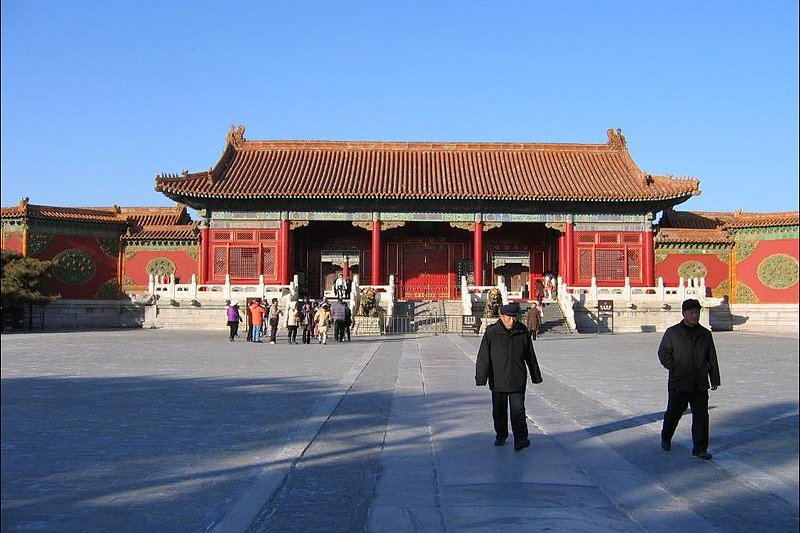 Forbidden City, Beijing
Forbidden City, Beijing
Author: Jakub Halun

The English name, Forbidden City, is a loose translation of the Chinese name of the place, Zijin Cheng, which literally means Purple Forbidden City. It is also often translated as Forbidden Palace, after the Manchu name of it, Dabkuri dorgi hoton, which literally means Layered Inner City. Today, the Chinese calls it Gugong, meaning Former Palace, and the museum based within it is called Gugong Bowuyuan, or Palace Museum.
Today the Forbidden City comprises 980 buildings. Originally it has 8707 bays of rooms - indeed the architecture called for 9,999 rooms, covering an area of 1,829,000 sq ft (170,000 sq m) although today the floor area totals only 1,614,600 sq ft (150,000 sq m).The Forbidden City is surrounded by a 171 ft (52m) wide, 6m deep moat and a 33ft (10m) high wall. The wall served both as a defensive walls as well as retaining walls. They are surfaced on both sides with three layers of specially baked bricks.
 Forbidden City, Beijing
Forbidden City, BeijingSource: http://commons.wikimedia.org/wiki/File:Forbiddencitybeijing.jpg
Author: giladr

View WorldGreatestSites: Forbidden City in a larger map
The Hall of Supreme Harmony is the largest surviving wooden structure in China. It rises to 30 meters from the square.At the ceiling is an intricate caisson decorated with a coiled dragon. From its mouth is a chandeliar-let ornament of metal balls, called the Xuanyuan Mirror. According to legend, the metal balls will drop on any emperor not worthy to sit on the throne. It was created in the Ming Dynasty. One of the emperors in the Qing dynasty is said to have moved the throne slightly backwards, to avoid having the metal balls right above him.
Behind the Hall of Supreme Harmony is the Hall of Central Harmony, a private quarters for the emperor to prepare and rest in between ceremonies. Behind it, the Hall of Preserving Harmony is used rehearsing ceremonies. It is also where the final stage of the Imperial Examination is held. The imperial throne is located in all three halls.
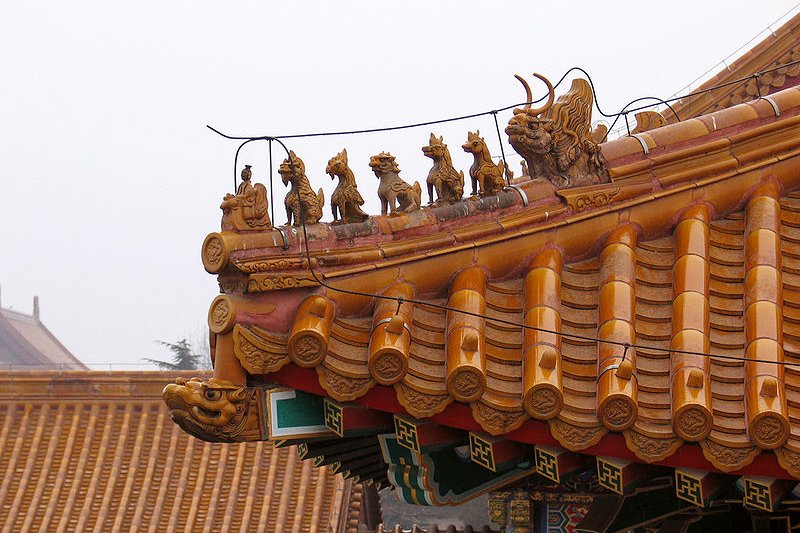 Roof Ornamentation, Forbidden City
Roof Ornamentation, Forbidden City
Author: giladr

View WorldGreatestSites: Forbidden City in a larger map
Exploring the Forbidden City
The Forbidden Palace is divided into two parts: the Outer Court, on the southern part of the complex, and the Inner Court (shaded opaque red in Map 2). The Outer Court is a place for ceremonies. Entering from the Meridian Gate (1 in Map 1), visitors arrive at a large square. The Inner Golden Water River, crossed by five bridges are located here. In front of it is the Gate of Supreme Harmony (2 in Map 1). Passing through it, visitors arrive at the Hall of Supreme Harmony Square. On this square is a three-tier white marble terrace. Standing on this terrace are the main palace complex. Lined up in a row from south to north, they are the Hall of Supreme Harmony (3 in Map 1), Hall of Central Harmony (4 in Map 1), and Hall of Preserving Harmony (5 in Map 1).The Hall of Supreme Harmony is the largest surviving wooden structure in China. It rises to 30 meters from the square.At the ceiling is an intricate caisson decorated with a coiled dragon. From its mouth is a chandeliar-let ornament of metal balls, called the Xuanyuan Mirror. According to legend, the metal balls will drop on any emperor not worthy to sit on the throne. It was created in the Ming Dynasty. One of the emperors in the Qing dynasty is said to have moved the throne slightly backwards, to avoid having the metal balls right above him.
Behind the Hall of Supreme Harmony is the Hall of Central Harmony, a private quarters for the emperor to prepare and rest in between ceremonies. Behind it, the Hall of Preserving Harmony is used rehearsing ceremonies. It is also where the final stage of the Imperial Examination is held. The imperial throne is located in all three halls.
 Roof Ornamentation, Forbidden City
Roof Ornamentation, Forbidden CitySource: http://commons.wikimedia.org/wiki/File:D%C3%A9tail_toiture_Cit%C3%A9_interdite.jpg
Author: Shakti

The Inner Court is located beyond the Hall of Preserving Harmony. It is entered through the Gate of Heavenly Purity (between 5 and 6 on Map 1) This is the private quarters of the Emperor and his family. It also comprises three halls on a north-south axis. The southernmost is the Palace of Heavenly Purity (6 in Map 1). This is the residence of the emperor. However, during the Qing Dynasty, the Yongzheng Emperor decided to live in the smaller Hall of Mental Cultivation (14 in Map 1), to the west, as respect to the memory of the Kangzi Emperor. During that time, it became the emperor's audience hall.
The Hall of Union (7 in Map 1) is a square structure with a pyramidal roof. It houses the 24 imperial seals of the Qing Dynasty, and other ceremonial items.
The Palace of Earthly Tranquility (8 in Map 1) is the residence of the empress. During the Qing Dynastry, a large part of it was converted for shamanist worship. Since the reign of the Yongzheng Emperor, the empress moved out of the Palace of Earthly Tranquility, though the Emperor retained two chambers here for use on the wedding night.
To the east and west of the three main halls of the Inner Court are the residential quarters of the emperors' concubines and children. The Hall of Mental Cultivation because the residence of the emperor starting from Yongzheng. Offices of the mandarins and other key government bodies are located around the Hall.
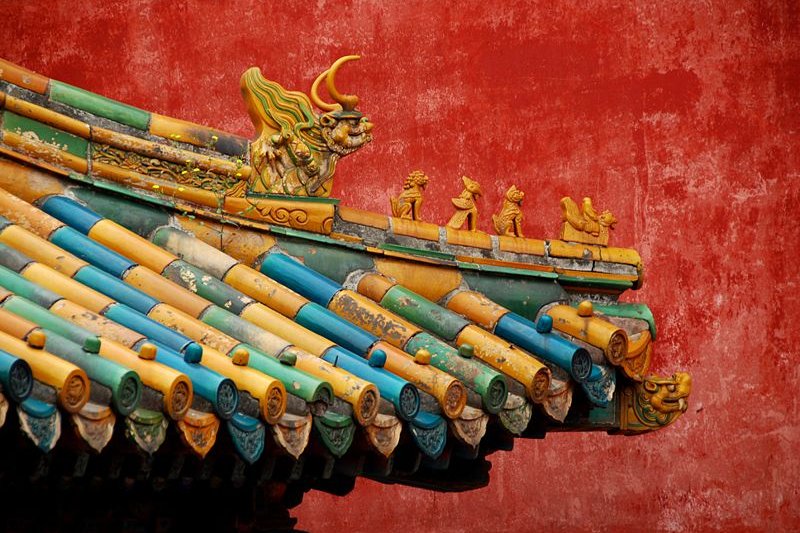 Details of the Forbidden City
Details of the Forbidden City
Author: Shakti

The Inner Court is located beyond the Hall of Preserving Harmony. It is entered through the Gate of Heavenly Purity (between 5 and 6 on Map 1) This is the private quarters of the Emperor and his family. It also comprises three halls on a north-south axis. The southernmost is the Palace of Heavenly Purity (6 in Map 1). This is the residence of the emperor. However, during the Qing Dynasty, the Yongzheng Emperor decided to live in the smaller Hall of Mental Cultivation (14 in Map 1), to the west, as respect to the memory of the Kangzi Emperor. During that time, it became the emperor's audience hall.
The Hall of Union (7 in Map 1) is a square structure with a pyramidal roof. It houses the 24 imperial seals of the Qing Dynasty, and other ceremonial items.
The Palace of Earthly Tranquility (8 in Map 1) is the residence of the empress. During the Qing Dynastry, a large part of it was converted for shamanist worship. Since the reign of the Yongzheng Emperor, the empress moved out of the Palace of Earthly Tranquility, though the Emperor retained two chambers here for use on the wedding night.
To the east and west of the three main halls of the Inner Court are the residential quarters of the emperors' concubines and children. The Hall of Mental Cultivation because the residence of the emperor starting from Yongzheng. Offices of the mandarins and other key government bodies are located around the Hall.
 Details of the Forbidden City
Details of the Forbidden CitySource: http://commons.wikimedia.org/wiki/File:Forbidden_city_colors.JPG
Author: Drolexandre

To the northeast of the Inner Court is the Palace of Tranquil Longevity (15 in Map 1). It is a scaled-down version of the Forbidden City, complete with Outer Court, Inner Court, gardens and temples. It was built by the Qianlong Emperor for his own retirement. The entrance to it is at the Nine Dragon Screen.
The Imperial Garden is located north of the Palace of Earthly Tranquility, before the retaining wall. The Gate of Diving Might (13 in Map 1) leads northwards out of the Forbidden City.
The Forbidden City was turned into the Palace Museum in 1924, allowing commoners to enter for the first time, and glimpse a fraction of its extensive collection of treasures and artwork. During the Japanese invasion of China, the treasures were spirited for safekeeping in different parts of China. While the majority of it was brought back to Beijing after the war, a big portion is still residing at the National Palace Museum in Taipei. The National Palace Museum of Taipei and the Palace Museum of Beijing were offshoots of the same institution was split following the Chinese Civil War.
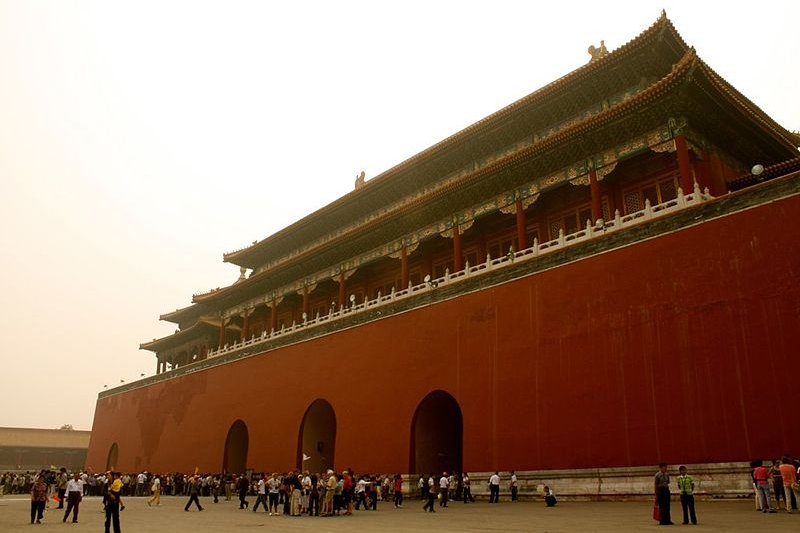 Hazy day at the Forbidden City
Hazy day at the Forbidden City
Author: Drolexandre

To the northeast of the Inner Court is the Palace of Tranquil Longevity (15 in Map 1). It is a scaled-down version of the Forbidden City, complete with Outer Court, Inner Court, gardens and temples. It was built by the Qianlong Emperor for his own retirement. The entrance to it is at the Nine Dragon Screen.
The Imperial Garden is located north of the Palace of Earthly Tranquility, before the retaining wall. The Gate of Diving Might (13 in Map 1) leads northwards out of the Forbidden City.
The Forbidden City was turned into the Palace Museum in 1924, allowing commoners to enter for the first time, and glimpse a fraction of its extensive collection of treasures and artwork. During the Japanese invasion of China, the treasures were spirited for safekeeping in different parts of China. While the majority of it was brought back to Beijing after the war, a big portion is still residing at the National Palace Museum in Taipei. The National Palace Museum of Taipei and the Palace Museum of Beijing were offshoots of the same institution was split following the Chinese Civil War.
 Hazy day at the Forbidden City
Hazy day at the Forbidden CitySource: http://commons.wikimedia.org/wiki/File:Forbidden_City_2.jpg
Author: Royd Andalis

A Starbucks cafe opened within the Forbidden City in 2000, sparking protests. It eventually closed in July, 2007. IBM Corporation is working on a website to present a virtual model of the Forbidden City. The project is expected to be ready some time in 2008. At each corner stands a Watch Tower (12 on Map 1). They are replicas of the Pavilion of Prince Teng and the Yellow Crane Pavilion, from Sung Dynasty paintings. As the Forbidden City was out of bounds to commoners, these watch towers are the only thing they could see from the retaining walls.
There are gates on each side of the wall. The main gate, Meridien Gate (1 on Map 1) is at the south. On the northern side is the Gate of Divine Might, facing Jinshan Park (M of Map 2). On the east side is the Donghua Gate, or East Glorious Gate (11 on Map 1) and on the west side is the Xihua Gate, or West Glorious Gate (10 on Map 1).
The Imperial Way is a stone path that forms the central axis of the Forbidden City. It runs north-south through the ancient city of Beijing, from the Gate of China to the south, right through the Forbidden City, and out at Jingshan Park in the north. During ancient times, only the Emperor may use the Imperior Way. The only exceptions are for the Empresses, during her wedding, and students that have graduated from the Imperial Examinations.
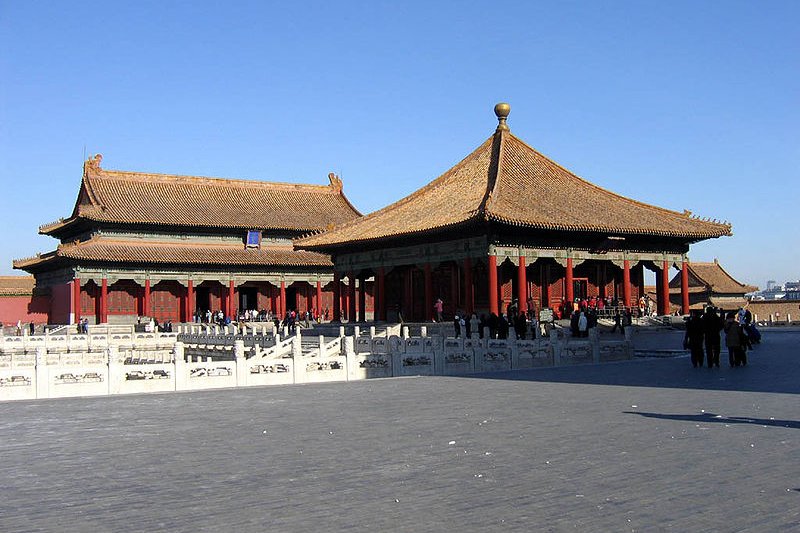 Hall of Preserving Harmony (left), Hall of Middle Harmony (right)
Hall of Preserving Harmony (left), Hall of Middle Harmony (right)
Author: Royd Andalis

A Starbucks cafe opened within the Forbidden City in 2000, sparking protests. It eventually closed in July, 2007. IBM Corporation is working on a website to present a virtual model of the Forbidden City. The project is expected to be ready some time in 2008. At each corner stands a Watch Tower (12 on Map 1). They are replicas of the Pavilion of Prince Teng and the Yellow Crane Pavilion, from Sung Dynasty paintings. As the Forbidden City was out of bounds to commoners, these watch towers are the only thing they could see from the retaining walls.
There are gates on each side of the wall. The main gate, Meridien Gate (1 on Map 1) is at the south. On the northern side is the Gate of Divine Might, facing Jinshan Park (M of Map 2). On the east side is the Donghua Gate, or East Glorious Gate (11 on Map 1) and on the west side is the Xihua Gate, or West Glorious Gate (10 on Map 1).
The Imperial Way is a stone path that forms the central axis of the Forbidden City. It runs north-south through the ancient city of Beijing, from the Gate of China to the south, right through the Forbidden City, and out at Jingshan Park in the north. During ancient times, only the Emperor may use the Imperior Way. The only exceptions are for the Empresses, during her wedding, and students that have graduated from the Imperial Examinations.
 Hall of Preserving Harmony (left), Hall of Middle Harmony (right)
Hall of Preserving Harmony (left), Hall of Middle Harmony (right)Source: http://commons.wikimedia.org/wiki/File:Forbidden_city_05.jpg
Author: Jacob Ehnmark

Beijing was the site of the Mongul imperial city during the Yuan Dynasty. When the Hongwu Emperor founded Ming Dynasty, he moved the capital south to Nanjing. The earlier Mongol palaces were ordered razed. His son Emperor Yong Le, moved the capital back to Beijing.
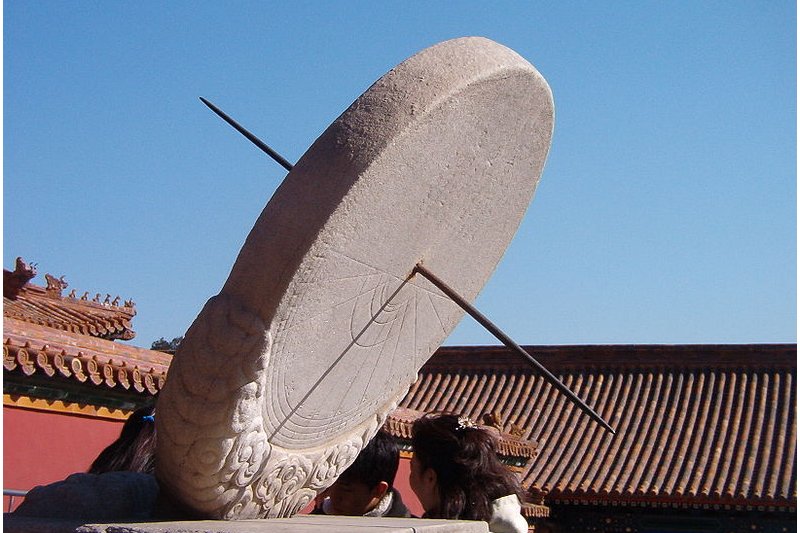 Imperial Sundial, Forbidden City
Imperial Sundial, Forbidden City
Author: Jacob Ehnmark

History of the Forbidden City
The foundation of the Forbidden City can be traced back to the Ming Dynasty. The area was already part of the Imperial City during the preceding Yuan (@ Mongol) Dynasty. When the Mongols were overcome by the Hongwu Emperor of the Ming Dynasty, he moved the capital from Beijing to Nanjing, and in 1369 ordered that the Mongol palaces be burnt down. He installed his son Zhu Di as the Prince of Yan, with his seat in Beijing. In 1402, Zhu Di usurped the throne, and became the Yongle Emperor (that's the emperor famous for sending Admiral Zhenghe all over Asia and beyond). He made Beijing his secondary capital, and in 1406, began construction of the Forbidden City.Beijing was the site of the Mongul imperial city during the Yuan Dynasty. When the Hongwu Emperor founded Ming Dynasty, he moved the capital south to Nanjing. The earlier Mongol palaces were ordered razed. His son Emperor Yong Le, moved the capital back to Beijing.
 Imperial Sundial, Forbidden City
Imperial Sundial, Forbidden CitySource: http://commons.wikimedia.org/wiki/File:Beijing_sundial.jpg
Author: Sputnikcccp

The Forbidden City was built between 1406 and 1420, during the reign of Emperor Yong Le, third emperor of the Ming Dynasty. At the time when it was built, Emperor Yong Le (or perhaps Zhu Di), had his capital in Nanjing. He usurped the throne from his nephew, and moved the capital to Beijing.
Construction of the Forbidden City took 14 years, and employed an estimated 200,000 workers. When it was completed in 1420, Emperor Zhu Di moved in and transferred the capital from Nanjing back to Beijing. However, just nine months after their construction, three main halls including there throne room were burnt down, and these were only reconstructed 23 years later.
The Forbidden City was the powerbase of the Ming Dynasty court from 1420 until 1644, when rebels under Li Zicheng captured it, and ushered in the shortlive Shun Dynasty. It only lasted one month, from April to May of 1644. General Wu Sangui of the former Ming Dynasty, with Manchu forces, ejected Li Zicheng out of the Forbidden City, causing some parts of the complex to be damaged in the processs. General Wu Sangui then set up the Qing Dynasty, under the young Shunzhi Emperor. The Qing Dynasty was to last until the last emperor of China at the beginning of the 20th century. During the period lasting 500 years, a total of 24 emperors were to make it their home.
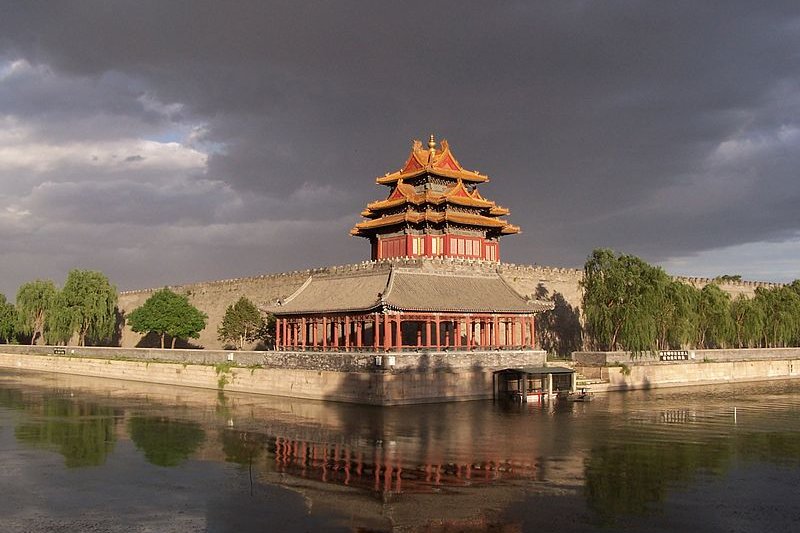 A corner tower of the Forbidden City
A corner tower of the Forbidden City
Author: Sputnikcccp

The Forbidden City was built between 1406 and 1420, during the reign of Emperor Yong Le, third emperor of the Ming Dynasty. At the time when it was built, Emperor Yong Le (or perhaps Zhu Di), had his capital in Nanjing. He usurped the throne from his nephew, and moved the capital to Beijing.
Construction of the Forbidden City took 14 years, and employed an estimated 200,000 workers. When it was completed in 1420, Emperor Zhu Di moved in and transferred the capital from Nanjing back to Beijing. However, just nine months after their construction, three main halls including there throne room were burnt down, and these were only reconstructed 23 years later.
The Forbidden City was the powerbase of the Ming Dynasty court from 1420 until 1644, when rebels under Li Zicheng captured it, and ushered in the shortlive Shun Dynasty. It only lasted one month, from April to May of 1644. General Wu Sangui of the former Ming Dynasty, with Manchu forces, ejected Li Zicheng out of the Forbidden City, causing some parts of the complex to be damaged in the processs. General Wu Sangui then set up the Qing Dynasty, under the young Shunzhi Emperor. The Qing Dynasty was to last until the last emperor of China at the beginning of the 20th century. During the period lasting 500 years, a total of 24 emperors were to make it their home.
 A corner tower of the Forbidden City
A corner tower of the Forbidden CitySource: http://commons.wikimedia.org/wiki/File:Sunset_of_the_Forbidden_City_2006.JPG
Author: kallgan

Under the reign of the Qing rulers, some names of the buildings within the complex were changed, from "Supremacy" to "Harmony", and name plates installed bearing the names written in Chinese as well as Manchu.
The Forbidden City was the seat of the Ming Dynasty from 1420 until 1644, when the Manchus overcome the Mings. Prince Regent Dorgon proclaimed the Qing Dynasty as the successor to the Ming Dynasty with a ceremony at the Forbidden City. Prince Regent Dorgon put a five-year-old on the throne, making him the ruler of all China. The Forbidden City was not impenetrable. In 1860, Anglo-French forces took control of it, and occupied it until the end of the Second Opium War. In 1900, the Empress Dowager had to flee the Forbidden City during the Boxer Rebellion.
The Forbidden City was the seat of the Qing Dynasty until the very last emperor, Puyi, whose reign ended in 1912 with the formation of the new Republic of China government. After his abdication, Puyi and his family continued to occupy the Inner Court of the Forbidden City until 1925, when Feng Yuxiang took control of Beijing in a coup and expelled Puyi from his home. On October 10, 1925, sections of the Forbidden City was open to the public for the first time, as the Palace Museum, and the Chinese people had the chance to view some of the treasures stored within.
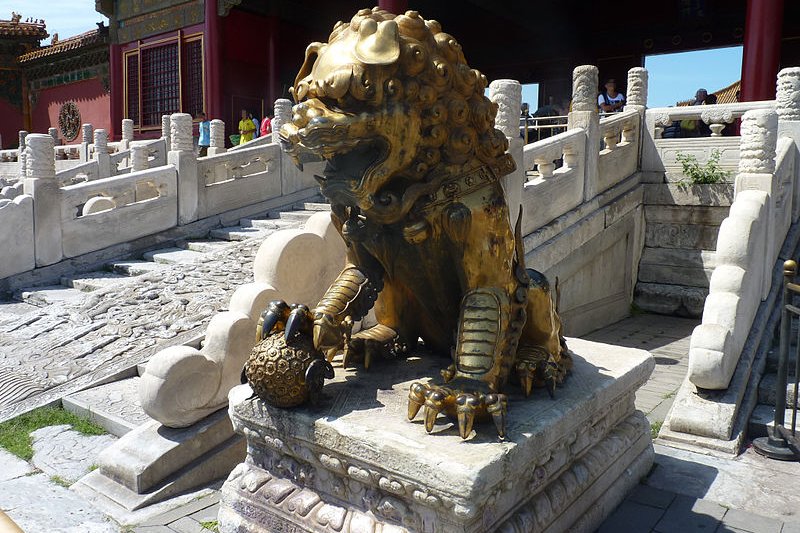 Guardian Lions, Forbidden City
Guardian Lions, Forbidden City
Author: kallgan

Under the reign of the Qing rulers, some names of the buildings within the complex were changed, from "Supremacy" to "Harmony", and name plates installed bearing the names written in Chinese as well as Manchu.
The Forbidden City was the seat of the Ming Dynasty from 1420 until 1644, when the Manchus overcome the Mings. Prince Regent Dorgon proclaimed the Qing Dynasty as the successor to the Ming Dynasty with a ceremony at the Forbidden City. Prince Regent Dorgon put a five-year-old on the throne, making him the ruler of all China. The Forbidden City was not impenetrable. In 1860, Anglo-French forces took control of it, and occupied it until the end of the Second Opium War. In 1900, the Empress Dowager had to flee the Forbidden City during the Boxer Rebellion.
The Forbidden City was the seat of the Qing Dynasty until the very last emperor, Puyi, whose reign ended in 1912 with the formation of the new Republic of China government. After his abdication, Puyi and his family continued to occupy the Inner Court of the Forbidden City until 1925, when Feng Yuxiang took control of Beijing in a coup and expelled Puyi from his home. On October 10, 1925, sections of the Forbidden City was open to the public for the first time, as the Palace Museum, and the Chinese people had the chance to view some of the treasures stored within.
 Guardian Lions, Forbidden City
Guardian Lions, Forbidden CitySource: http://commons.wikimedia.org/wiki/File:%E7%9C%8B%E9%97%A8%E7%9A%84%E7%8B%AE%E5%AD%901.JPG
Author: Mummyyx

When Japanese forces advanced on China, the treasures of the Forbidden City were secreted out. They were transported first to Nanjing, and then to Shanghai, and when Shanghai was also threatened by Japanese invasion, the treasures were transported further west. To prevent them from being intercepted, they were split into three lots. One went north towards Shaanxi, another taken up the Yangtze River to Sichuan, and one more moved south to Guangxi. In a cat-and-mouse game, the treasures were often just a few hours ahead of the invading Japanese forces. In the end, the treasures all reached Sichuan, and there they stayed until the end of the war.
When the Japanese captured the Forbidden City, there was no valuable inside. They were only able to remove a few bronze tubs and a few cannons. Most of these were recovered after the war, in Tianjin.
When the war had ended, the treasures stored in Sichuan were moved to Nanjing and to Beijing. Miraculously, nothing was lost or damaged. But more turbulent times lay ahead.
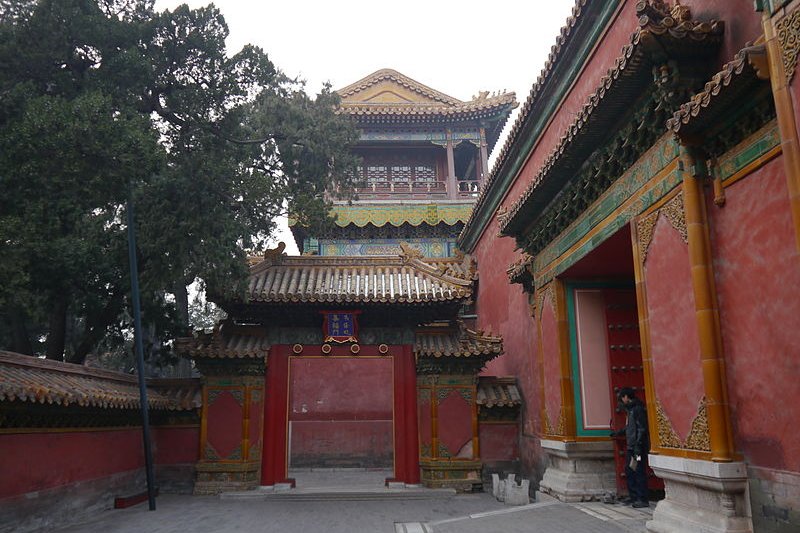 Imperial Garden, Forbidden City
Imperial Garden, Forbidden City
Author: Mummyyx

When Japanese forces advanced on China, the treasures of the Forbidden City were secreted out. They were transported first to Nanjing, and then to Shanghai, and when Shanghai was also threatened by Japanese invasion, the treasures were transported further west. To prevent them from being intercepted, they were split into three lots. One went north towards Shaanxi, another taken up the Yangtze River to Sichuan, and one more moved south to Guangxi. In a cat-and-mouse game, the treasures were often just a few hours ahead of the invading Japanese forces. In the end, the treasures all reached Sichuan, and there they stayed until the end of the war.
When the Japanese captured the Forbidden City, there was no valuable inside. They were only able to remove a few bronze tubs and a few cannons. Most of these were recovered after the war, in Tianjin.
When the war had ended, the treasures stored in Sichuan were moved to Nanjing and to Beijing. Miraculously, nothing was lost or damaged. But more turbulent times lay ahead.
 Imperial Garden, Forbidden City
Imperial Garden, Forbidden CitySource: http://commons.wikimedia.org/wiki/File:China-beijing-forbidden-city-P1000256.jpg
Author: Adamantios

In 1947, with the Kuomintang losing the Chinese Civil War, Chiang Kai-shek ordered that the treasures of the Forbidden City and the National Museum in Nanjing be shipped to Taiwan, to prevent them from falling into Communist hands. In any case, only the treasures stored in Nanjing got to Taipei - where they form the core collection of the National Palace Museum of Taipei. Those in Beijing stayed where they were.
The People's Republic of China was proclaimed at Tiananmen Square, right in front of the Forbidden City. During the first few decades of Communist rule in China, the Forbidden City became a neglected relic - many proposals were put forward on how best to make use of this prime real estate, to turn it into a park, a transport hub, or even an amusement centre. It suffered much indignity under the Cultural Revolution, with the goals of Mao Zedong to bring to an end the Four Olds - Old Custom, Old Culture, Old Habits and Old Ideas. Fortunately, despite all that it went through, the Forbidden City was left to stand.
The far-sighted Premier Zhou Enlai prevented further destruction of the Forbidden City by sending troops to guard it. From 1966 to 1971, the gates into the Forbidden City were sealed. It was only in 2005 that a massive restoration project kicked off to repair and restore all the buildings in the Forbidden City.
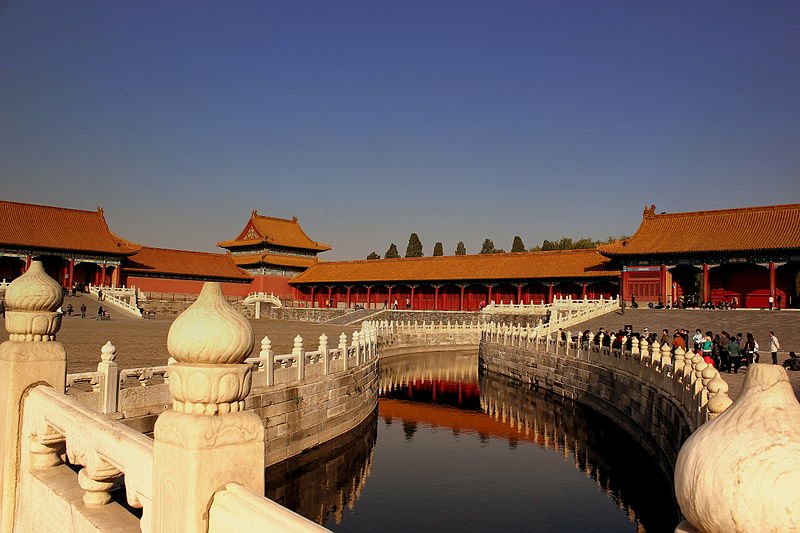 Gate of Blending Harmony, Forbidden City
Gate of Blending Harmony, Forbidden City
Author: Adamantios

In 1947, with the Kuomintang losing the Chinese Civil War, Chiang Kai-shek ordered that the treasures of the Forbidden City and the National Museum in Nanjing be shipped to Taiwan, to prevent them from falling into Communist hands. In any case, only the treasures stored in Nanjing got to Taipei - where they form the core collection of the National Palace Museum of Taipei. Those in Beijing stayed where they were.
The People's Republic of China was proclaimed at Tiananmen Square, right in front of the Forbidden City. During the first few decades of Communist rule in China, the Forbidden City became a neglected relic - many proposals were put forward on how best to make use of this prime real estate, to turn it into a park, a transport hub, or even an amusement centre. It suffered much indignity under the Cultural Revolution, with the goals of Mao Zedong to bring to an end the Four Olds - Old Custom, Old Culture, Old Habits and Old Ideas. Fortunately, despite all that it went through, the Forbidden City was left to stand.
The far-sighted Premier Zhou Enlai prevented further destruction of the Forbidden City by sending troops to guard it. From 1966 to 1971, the gates into the Forbidden City were sealed. It was only in 2005 that a massive restoration project kicked off to repair and restore all the buildings in the Forbidden City.
 Gate of Blending Harmony, Forbidden City
Gate of Blending Harmony, Forbidden CitySource: http://commons.wikimedia.org/wiki/File:FORBIDDEN_CITY_BEIJING_CHINA_OCT_2012_(8176106800).jpg
Author: calflier001

Looking for information on Penang? Use this Map of Roads in Penang to zoom in on information about Penang, brought to you road by road.

Author: calflier001

Visiting Forbidden City
The Forbidden City is open daily from 8:30 am to 5:00 pm from April to October, and from 8:30 am to 4:30 pm from November to March. Latest updates on Penang Travel Tips
Latest updates on Penang Travel Tips
 Map of Roads in Penang
Map of Roads in Penang
Looking for information on Penang? Use this Map of Roads in Penang to zoom in on information about Penang, brought to you road by road.
Copyright © 2003-2025 Timothy Tye. All Rights Reserved.

 Go Back
Go Back